Gas corrector: functions and frequency of checking fuel volume correction devices
Agree, gas supply to the apartment is much easier than with a private house. In the cottage, a boiler and a gas stove, and in particular a boiler, consume methane by cubic meters, carefully calculated by a flow meter mandatory since 2019.
But thermal calorific value and pressure of blue fuel are unstable, so the meter can wind up too much. The gas corrector will be able to correct the situation. It can reduce the “wound” cubic meters to the standard standard methane state of aggregation. The special convenience of the device - almost no attention is required.
We will talk about it, explain the effect of temperature on the cost of main gas and how the corrector helps reduce utility costs.
The content of the article:
What does this device do?
The purpose of the volumetric gas flow corrector is to measure pressure, temperature and the working volumes of methane fuel recorded by the flowmeter. The device is equipped with signal converters according to measurable criteria received from a gas meter and analyzed by a microprocessor.
The compressibility factor is calculated either by the corrector itself (GOST 30319.2-2015), or substituted according to a predefined value.
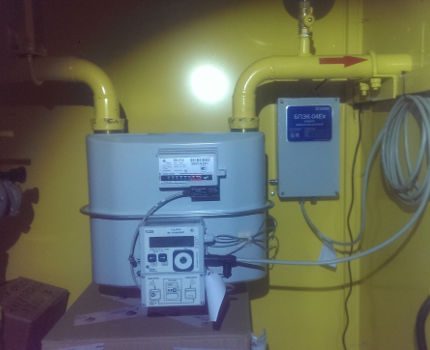
The measurement results allow us to convert the consumed cubic meters of natural gas into volume under standard methane conditions in accordance with GOST 2939-63, taking into account the conditionally constant parameters of gas fuel - density under standard conditions, CO content2 and N2.
Relative error tolerances in the full range of operating temperatures are:
- by pressure measurement +/- 0.4%;
- by temperature measurement +/- 0.3%;
- to bring the volume to standard conditions +/- 0.5%;
- by measuring the volume of methane under operating conditions +/- 0.05%.
As the corrector accumulates data on the parameters of the incoming gas, they are archived at a 60-minute interval. Depending on the model of the device, it stores data for the last 270-365 days at the time of access to the archive. Archived data is stored on a smart card.

An autonomous power supply unit of the device will provide it with energy for at least 7 full days, provided that the interface screen is active for no more than 15 minutes during this period. It should be noted that the main power source for the methane data correction device is the household power supply through an AC to DC converter with a voltage of 9 V (current 100 A).
If necessary, the working functions of the corrector can be used to control blue fuel consumptionby setting the daily and monthly limit for tracking the balance.
Features of installation of the corrector
The methane accounting characteristic correction device is connected to a flowmeter equipped with a pulse output signal (frequency range up to 2-8 Hz, pulse weight 0.01-100 m3) Connection to gas meter with a position-coding mechanism (encoder) installed in the counting head.
Physical fixing of the correction device (standardization) of the data of the consumed volume of gas fuel is performed on the meter body (if there is an installation place), on the bracket, or on the wall. The correction device usually weighs up to 3 kg.
Be sure to ground the corrector using a rectangular bus with a cross section of 4 mm or more2. External devices are connected to the device with a shielded cable with a wire cross section from 0.25 mm2, no more than 10 m long.
Ways to integrate the flowmeter with the corrector
In the first version, gas consumption control elements are supplied separately: a gas meter with an electrical output (for example, a reed switch magnet); a pressure sensor having a unified current output; temperature sensor (electronic resistance thermometer); correction device to standardize the characteristics of the consumed gas volume.
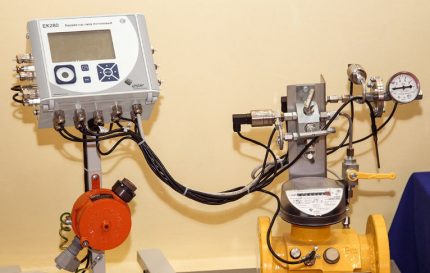
United in a complex, these devices form a single system of measuring instruments. However, you can use it in this capacity only after agreement with the local department of the State Standard. The advantage of this complex is the admissibility of standardization of readings from several gas meters (i.e., from several gas pipeline inlets).
The disadvantage of such a system is the different timing of verification of its elements, among which the most often need to check the temperature and pressure sensors. It will be easier not to carry out verification of the latter, but simply to replace them with new ones. The general advantage of such a measuring complex is its final cost is lower than that of a factory multi-channel system.
In the second version, the measuring complex is created entirely at the manufacturer. It is important to choose a system with a close intertesting period of elements. For example, the LGK-Ex rotary gas meter has a verification period of two years, and the corrector and pressure sensor have 5 years. This means the need to verify the entire complex 2.5 times in a five-year interval of use, which is inconvenient and disadvantageous.
How to configure the device?
Constant information is not required; they are entered at the device manufacturer. Those. after installing and connecting the wires to the data source (gas meter), the corrector is completely ready for operation.
Access to change the corrector data is divided between three parties - the metrological service, the gas supply organization with which contract signed for service, and the consumer.Each side has its own code (eight-digit combination of numbers), which allows access to the device’s program menu.
The consumer is given the lowest access priority, and the highest - to the metrological organization. In fact, the user can only control the output of data to the device interface - a full or short display mode.
Changes to the parameters required for calculating the volume of gas fuel consumed (the "metrological" part of the software) are allowed only with official calibration, performed exclusively during the verification of natural gas volume correctors. The button of the calibration lock is protected by a hinged seal (easily destructible!).
Frequency of verification
Verification verification of the validity of measurements made by the device for correcting the consumed volume of natural gas is required every 5 years (subject to the technical correctness of the corrector during this period).
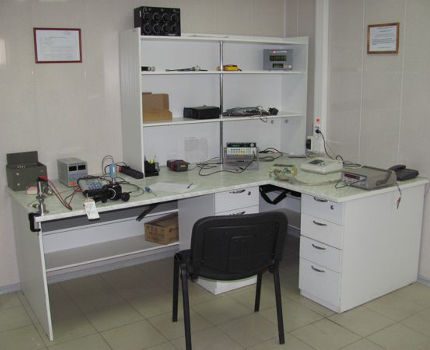
Verification methods are developed by manufacturers of corrective devices with the obligatory approval of the Federal State Unitary Enterprise “VNIIMS” or regional FBU “TsSM”. The right to perform verification tests is granted to the state metrological service (FBU "TsSM") or to private metrological services that have the corresponding certificate of Rosaccreditation.
Natural gas meter correction goals
Note that although the passport operating temperature range of the flow meter can be +/- 40aboutC, it does not matter to the temperature coefficient increasing the price of gas fuel.
The rules of civil gas supply for household purposes No. 549 state the need to multiply the methane consumed by the meter by the coefficient of reduction to standard conditions (designation - Vp), normalized by GOST 2939-63:
- gas temperature - 20aboutC (also 293.15aboutTO);
- gas pressure - 760 mm Hg (also 101.325 kN / m2);
- gas humidity - equal to zero.
As the “outdoor” temperatures change over the calendar year, different coefficients of bringing to the “gas standard” are applied to the consumed gas volume - they are always higher in the winter months.
The values of these coefficients are set by the Federal Metrology Agency. In particular, since 2019, temperature coefficients have been in force in the regions of Russia, as determined by order no.

To avoid multiplying the consumed volume by the regional coefficient established by the norms, the homeowner must choose a meter equipped with a temperature compensator to take into account gas consumption.
The location of the gas meter - external (outside the house) or internal (in the technical room) - does not matter. Here, either payment for the consumed volume of methane, taking into account the temperature coefficient, or the installation of a gas flow meter with an integrated temperature compensator.
Compensating temperature differences of gas fuel, the device is a bimetallic plate integrated into the volume measurement mechanism when methane passes through the meter. Under the influence of the temperature of natural gas, the plate bends in a certain way and affects the process of accounting for gas consumption so that the readings correspond to standard conditions of fuel condition.
What is the use of correcting gas consumption?
To consumers in settlements, gas fuel is supplied from the main gas pipeline by a system of common high and medium pressure collectors stretched for tens of kilometers.
Before transferring gas volumes to a company directly supplying fuel to end consumers via gas pipelines, the main methane parameters are measured at the outlet of the gas distribution station - volume (or flow rate), temperature and pressure. These parameters directly affect the income of organizations involved in the transport and distribution of methane to households.
Therefore, bringing the volume of methane burned in boilers, boilers and gas stoves to standard temperature conditions in accordance with GOST 2939-63 are initially conducted in the interests of natural gas suppliers.
Convenience to regional gas services
In the frosty winter months, the pressure in the air-gas pipeline decreases, since its value is directly proportional to the gas temperature (Charles law). In this case, the density of the gaseous fuel increases, and the volume decreases (Boyle-Mariotte law).
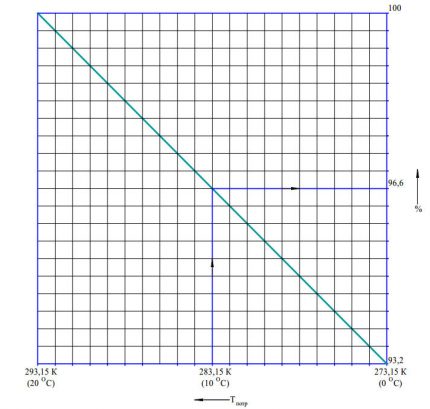
As a result, there is a so-called imbalance between the supplied and consumed volume of blue fuel. Those. a home gas meter will record a smaller number of cubic meters of methane than is actually spent by the heating appliances of the cottage.
In contrast, at summer temperatures above 20aboutWith the gas meter of a private house will show a higher methane consumption than actually received. However, less natural gas is burned by households in the summer, because its main consumption is associated with the heating period.
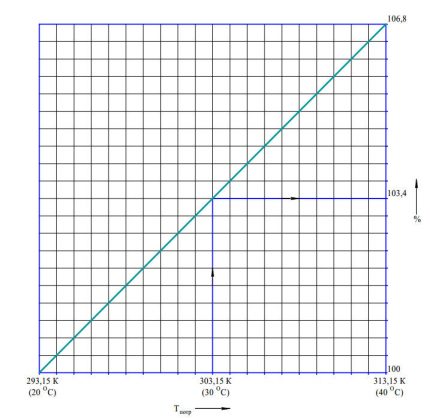
Thus, the use by households of a full-fledged gas corrector or only a temperature corrector, or payment of the consumed volume of methane fuel with extra coefficients, is usually to the benefit of the gas supplying organization.
But in one, by the way, rather frequent situation with gas supply, a device that corrects the parameters of blue fuel can bring real benefits to the homeowner.
Benefits to homeowners
The frosty months of residents of suburban real estate worried about another problem - the excessively low pressure in the gas transmission network, complicating the process of heating the house. The flame above the burner barely burns and the boiler equipment either shuts itself down or warms up coolant in a house heating circuit not higher than 60aboutWITH.

The reason for the weak gas supply in winter is understandable - heating outdoor and wall mounted boilers more methane is burned in houses; otherwise, households simply cannot be heated. And most owners of suburban cottages with year-round living put up with weakened pressure in the gas pipeline, supplementing gas heat generators with boiler equipment using alternative fuels (wood, coal).
However, they do not realize that they are not only forced to endure the cold atmosphere of the house every winter, but also overpay for cubic meters of gas!
According to the "gas" Boyle-Mariotte law, when the pressure drops in the gas medium, its volume increases. Those. when the pressure in the “air” decreases, the volume of methane entering the flowmeter increases and the meter starts rolling up non-existent cubic meters. Overpayment on “wound” gas bills can reach 5-7% for the heating season.
And only a flow meter with an electronic natural gas corrector, configured according to the "local" methane standardization parameters by the official metrological service, will allow consumers to pay cubic meters of blue fuel burned by thermal equipment at the actual consumption.
Conclusions and useful video on the topic
How to use the menu of the device for correcting the volume of consumed gas (for example, EK270):
How is the device for standardizing the volume of methane inside (for example, LNG 741):
How to read and adjust the parameters in the corrector menu (for example, LNG 761):
With the retrofit of the gas flow meter with a corrector, the savings in gas consumption will be noticeable if the consumption of blue fuel is more than 4 cubic meters per hour. Indeed, if you have to put up with weak pressure in the gas supplying the household, there is no reason to tolerate overpayments for non-existent volumes of gas consumption.
Want to share your own experience in using a gaseous fuel flow corrector? Please write comments in the block below, ask questions, post a photo on the topic of the article. It is possible that your recommendations will be useful to site visitors.

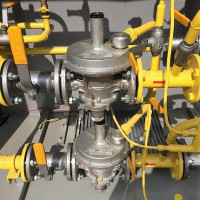 Gas pressure relief valve: types of devices + selection guidelines
Gas pressure relief valve: types of devices + selection guidelines  Maintenance of gas stoves in apartments: what is included in the maintenance, timing and frequency of service
Maintenance of gas stoves in apartments: what is included in the maintenance, timing and frequency of service 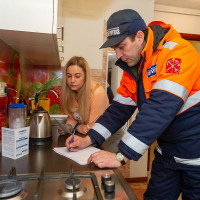 Gas connection in an apartment: procedure and rules for gas connection in apartment buildings
Gas connection in an apartment: procedure and rules for gas connection in apartment buildings 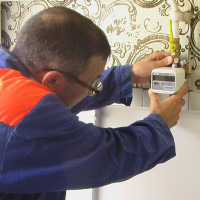 Warranty period for gas meters: service life and features of replacing gas meters
Warranty period for gas meters: service life and features of replacing gas meters  Why is a gas cylinder covered with hoarfrost: causes of freezing of gas in the cylinder and ways to prevent it
Why is a gas cylinder covered with hoarfrost: causes of freezing of gas in the cylinder and ways to prevent it 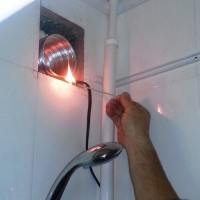 How to check the draft in a gas column: an overview of methods for checking traction and methods for dealing with reverse traction
How to check the draft in a gas column: an overview of methods for checking traction and methods for dealing with reverse traction  How much does it cost to connect gas to a private house: the price of organizing gas supply
How much does it cost to connect gas to a private house: the price of organizing gas supply  The best washing machines with dryer: model rating and customer tips
The best washing machines with dryer: model rating and customer tips  What is the color temperature of light and the nuances of choosing the temperature of the lamps to suit your needs
What is the color temperature of light and the nuances of choosing the temperature of the lamps to suit your needs  Replacement of a geyser in an apartment: replacement paperwork + basic norms and requirements
Replacement of a geyser in an apartment: replacement paperwork + basic norms and requirements